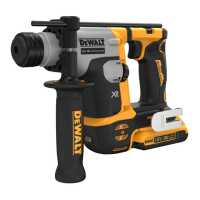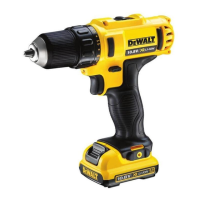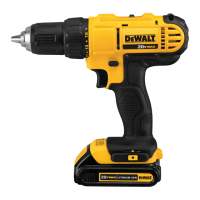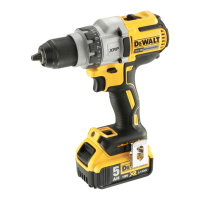10
English
The information provided in this section of the
manual is provided in good faith and believed to be
accurate at the time the document was created.
However, no warranty, expressed or implied, is
given. It is the buyer’s responsibility to ensure that its
activities comply with the applicableregulations.
Battery Pack
BATTERY TYPE
The DCH273 and DCH274 operate on 18V (20V
Max) batterypacks.
More batteries information, pls refer to Technical
Data
Storage Recommendations
1. The best storage place is one that is cool and
dry away from direct sunlight and excess heat
or cold. For optimum battery performance and
life, store battery packs at room temperature
when not inuse.
2. For long storage, it is recommended to store a
fully charged battery pack in a cool, dry place
out of the charger for optimalresults.
NOTE: Battery packs should not be stored
completely depleted of charge. The battery pack will
need to be recharged beforeuse.
Labels on Charger and Battery Pack
In addition to the pictographs used in this manual,
the labels on the charger and the battery pack may
show the following pictographs:
Read instruction manual before use.
See Technical Data for charging time.
Battery charging.
Battery charged.
Battery defective.
Hot/cold pack delay.
Do not probe with conductive objects.
Do not charge damaged battery packs.
Toxic fumes and materials are created when
lithium ion battery packs areburned.
• If battery contents come into contact with
the skin, immediately wash area with mild
soap and water. If battery liquid gets into the
eye, rinse water over the open eye for
15 minutes or until irritation ceases. If medical
attention is needed, the battery electrolyte
is composed of a mixture of liquid organic
carbonates and lithiumsalts.
• Contents of opened battery cells may cause
respiratory irritation. Provide fresh air. If
symptoms persists, seek medicalattention.
WARNING: Burn hazard. Battery liquid
may be flammable if exposed to spark
orflame.
Transportation
DeWALT batteries comply with all applicable
shipping regulations as prescribed by industry and
legal standards which include UN Recommendations
on the Transport of Dangerous Goods; International
Air Transport Association (IATA) Dangerous Goods
Regulations, International Maritime Dangerous
Goods (IMDG) Regulations, and the European
Agreement Concerning The International Carriage
of Dangerous Goods by Road (ADR). Lithium-ion
cells and batteries have been tested to section 38.3
of the UN Recommendations on the Transport of
Dangerous Goods Manual of Tests andCriteria.
In most instances, shipping a
DeWALT battery pack
will be excepted from being classified as a fully
regulated Class 9 Hazardous material. In general,
the two instances that require shipping Class 9 are:
1. Air shipping more than two
DeWALT lithium-ion
battery packs when the package contains only
battery packs (no tools), and
2. Any shipment containing a lithium-ion battery
with an energy rating greater than 100 watt
hours (Wh). All lithium-ion batteries have the
watt hour rating marked on thepack.
Regardless of whether a shipment is
considered excepted or fully regulated, it is the
shipper's responsibility to consult the latest
regulations for packaging, labeling/marking and
documentationrequirements.
Transporting batteries can possibly cause fire if the
battery terminals inadvertently come in contact with
conductive materials. When transporting batteries,
make sure that the battery terminals are protected
and well insulated from materials that could contact
them and cause a shortcircuit.
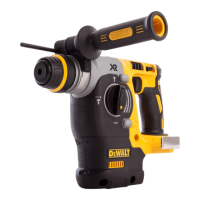
